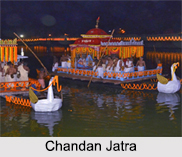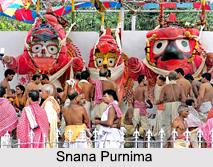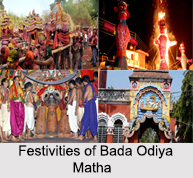 Festivals of Bada Odiya Matha are many. Most of the rituals and festivals that are performed in the Bada Odiya Matha are associated with the Jagannath Temple of Puri. Certain festivals of Bada Odiya Matha are similar to those of the Jagannath Temple in Puri. Besides the festivals, there are several rituals that take place in this monastery. These occasions are also celebrated with festive fervor. This is one of the most important "Rajangila Mathas". This particular matha has been granted special privilege to celebrate the festivals and rituals in the temple. It has been conferred the title of "Mahanayaka` Sari. Festivals, such as, Chandan Jatra, Dola Jatra, Simhasana Marjana, Dussehra and several others are celebrated by the matha.
Festivals of Bada Odiya Matha are many. Most of the rituals and festivals that are performed in the Bada Odiya Matha are associated with the Jagannath Temple of Puri. Certain festivals of Bada Odiya Matha are similar to those of the Jagannath Temple in Puri. Besides the festivals, there are several rituals that take place in this monastery. These occasions are also celebrated with festive fervor. This is one of the most important "Rajangila Mathas". This particular matha has been granted special privilege to celebrate the festivals and rituals in the temple. It has been conferred the title of "Mahanayaka` Sari. Festivals, such as, Chandan Jatra, Dola Jatra, Simhasana Marjana, Dussehra and several others are celebrated by the matha.
Structure of the Bada Odiya Matha
A bamboo construction is set up near the door of `Jayabijaya` and three lamps fed with ghee are kept on fire day and night for a month. The Bada Odiya Matha supplies these three lamps and the ghee which is needed to keep these lamps burning all through the month. These three lamps which are provided by the monastery are kept on one side of the bamboo structure and three other lamps in the same way fed with enough ghee supplied by the Radhakant Matha are set on the other side of this structure.
Festivities of Bada Odiya Matha
A number of festivals follow Bada Odiya Matha and each of them has a specific purpose to serve.
Chandan Jatra
 This festival is observed for 42 days. During this period the deputy of Lord Jagannath is taken in a decorated palanquin to the Narendra tank where the deity is anointed with sandal wood paste and made to circumambulate over the surface in a decorated boat. The monastery offers three pots of sweet water mixed with sugar and milk at the temple and one pot full of the same sweet water at the tank.
This festival is observed for 42 days. During this period the deputy of Lord Jagannath is taken in a decorated palanquin to the Narendra tank where the deity is anointed with sandal wood paste and made to circumambulate over the surface in a decorated boat. The monastery offers three pots of sweet water mixed with sugar and milk at the temple and one pot full of the same sweet water at the tank.
Rukuna Harana
A piece of black sari and necessary ingredients for the ritual bath of the goddess Bimala are offered and Bhog is also offered to her at Jagamohana.
Anasara
According to this ritual the deities are confined over a period of 15 days. During this time four pots of special preparation of food consisting of cheese, banana, sugar-candy and cream are offered daily to the deities. Scented oil is used for Lord Jagannath is supplied by the Matha.
Kanaka Mundel Seba Candua
The clothes which are used for the preparation of a canopy which is fixed overhead of the deities on the "simhasana" and those which are used for the preparation of pillows including cotton are supplied by the Bada Odiya Matha.
Adharapana
Three big pots of the same height as from the ground to the lips of the deities filled in with sweet water mixed with sugar-candy, cream, cheese and banana up to the brim, one for each deity are supplied by the monastery on the day the deities are carried out of the temple and installed on the cars for their journey to Gundichaghara.
Panti Bhoga
On reaching the Gundichaghara the deities are offered Bhoga of various kinds of foods (Panti). Similarly, on the return journey same types of Bhoga are offered by the monastery in the compound of the Gundichaghara.
Chandansarbanga
 While the deities are present at Gundichaghara they are anointed with sandalwood paste which is supplied by the monastery. A special Bhog consisting of cooked rice, dal and curry is offered to the deities at the temple during the occasion of the Snana Purnima.
While the deities are present at Gundichaghara they are anointed with sandalwood paste which is supplied by the monastery. A special Bhog consisting of cooked rice, dal and curry is offered to the deities at the temple during the occasion of the Snana Purnima.
Simhasana Marjana
Before the deities are carried back to the temple at the end of the car festival the Simhasana in the main temple where the deities are car festival the Simhasana in the main temple where the deities are installed is cleaned with water mixed with sandalwood paste, scented oil, etc.
Dol Jatra or Holi
On this occasion the deputy of the Lord Jagannath is carried ceremoniously to the Dolabedi and installed in a wooden structure which is hung on the arch to swing back and forth. This arch is anointed with five seers of til oil which is supplied by the monastery.
Celebration of Bada Odiya Matha
Special Bhoga prepared by the Bada Odiya Matha is offered for three days to the goddess Bimala during this festival. The required quantities of rice and vegetables are supplied by the matha.
For this purpose ovens are put into use. For the preparation of rice six ovens are used. Of these chulas or ovens, four are used for the preparation of the Bhoga which are offered to Lord Jagannatha. A separate house is allotted to the Bada Odiya Matha within the temple complex for storing the foodstuffs.



















